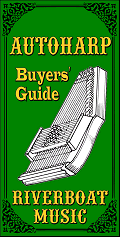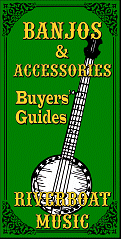


|


Autoharp Article Index
In late 2015, I put together a very short "buyer's guide" for autoharps, attempting to explain the best choices for today's autoharp beginners. Within 16 months, and no promotion to speak of, the article had had thousands of hits, which told me that there is a need for more information about these often underrated instruments.I also acquired one that I thought would be fun bringing back to life and occassionally using on recordings. But before long, I got a lot of reader questions. I did what I always do - if I get the same or related questions from several readers, I use the answers I wrote to each of them as the basis for an article. So now I'm up to four articles, not counting this one, which is going to be an introduction to the rest of them.
- Autoharp Buyer's Guide - this is my first article about autoharps, a "buyer's guide" on the RiverboatMusic.com(tm) web site. It briefly outlines the history of the things and explains the difference between Oscar Schmidt autoharps and Chromaharps.
- Autoharp Factory Tunings - Most commercially available autoharps have included the same chords as the first 12-chord autoharps of a century ago, providing chords that would support most songs in the keys of Bb, F, and C. As autoharps gained more chords, they gained the ability to support more keys, including Eb and G. Plus they "fleshed out" the relative minors, secondary dominants, and other chords that complex songs in F and Bb often need (Cm, C7, Gm, G7, Dm, D7, Am, A7, etc.). So if your guitar player doesn't mind playing all of his G or D songs with the capo on the third fret (key of Bb or F), you can play along like gangbusters.
But what if he won't? Or what if your fiddle player insists on playing all of those classic A fiddle tunes in the key of A? Well, there are ways to reconfigure your autoharp for such purposes, but unless you know what the starting point is, you'll never be able to figure out what you need to change. So the Autoharp Factory Tunings article describes the standard setups and the most common variations available on Oscar Schmidt and Chromaharp autoharps between 1920 and today. You'll also learn something about the most popular 12, 15, and 21-chord autoharp models in both lines.
- Making Your Autoharp Folk-Friendly - This article describes the easiest way to convert a 21-chord Oscar Schmidt to play most songs in the key of D, and many in the key of A. It also gives suggestions for conversions that will give you most chords you need to play in E as well. If you have a 15-chorder, don't feel left out. It will take a little more work, but we also suggest ways to sacrifice chords like Ab, Eb, and Bb7 to get more folk-friendly chords on a 15-chorder as well.
- What is a Diatonic Autoharp?" - The short answer is that if you only ever play in one or two (or maybe three) keys, you can reconfigure your autoharp to retune strings you never use in those keys so that they double strings you do use, providing a far richer sound. Yes, if you reconfigure your 'harp to play in G and D, with lots of extra ringing strings, you won't be taking it to those Eb/Bb Polka gigs any more. But most autoharp players who do much gigging have multiple autoharps anyway. By the way, 15-chorders work for this almost as well as 21-chorders, and in some parts of the country, they're easy to find in good condition cheap.
- Autoharps for People with Short Arms - Okay, that's a dumb name for an article, but I've encountered people who, because of their stature or nerve damage or something else, can't play a full-sized autoharp conveniently. Turns out that a wide variety of alternative instruments that would have served their needs were made in the 1960s. Though they're nearly impossible to find today, I wanted to describe them just in case one turns up. Plus show one example of a custom autoharp that costs a lot more but whose owners think it's worth it.
- How Much is My Autoharp/Chromaharp Worth? - I got started researching autoharps in part because I think they are a very underrated class of instruments. That's good news for anyone seeking to buy one, but not such good news for anyone who has one to sell - unless it's an upgrade instrument in good condition. This article will hopefully help you figure out if yours falls into that category, and determine what autoharps like yours are selling for.
Conclusion
I still have a lot of work to do on my own autoharps, and I'll probably be updating those articles as I learn more about them. But In the meantime, please get in touch if you have any questions, suggestions, or corrections.Best of luck!
 Whatever else you get out of our pages, I hope you enjoy your music and figure out how to make enjoyable music for those around you as well.
Whatever else you get out of our pages, I hope you enjoy your music and figure out how to make enjoyable music for those around you as well.
And please stay in touch!
- Paul
![]()
![]()
![]()


![]()
![]()
![]()
![]()
http://CreekDontRise.com
http://SchoolOfTheRock.com
http://classictrainsongs.com
All materials, illustrations, and content on this web page are copyrighted (c) 2017 by Paul D. Race. All rights reserved.
Creek Dont' Rise(tm) is a participant in the Amazon Services LLC Associates Program, an affiliate advertising
program designed to provide a means for sites to earn advertising fees by advertising and linking to Amazon.com.
For questions, comments, suggestions, trouble reports, etc. about this page or this site, please contact us.
| Visit our other pages: | |||||
| - Music - | |||||

|
 |
 |

|

|

|

|

|

|

|

|

|

|

|

|

|

|

|
| - Trains and Hobbies - | |||||
 |

|

|  |
 |

|
| - Christmas Memories and Collectibles - | |||||
 |

|
 |

|
 |

|
| - Family Activities and Crafts - | |||||
 |

|

|

|

|

|